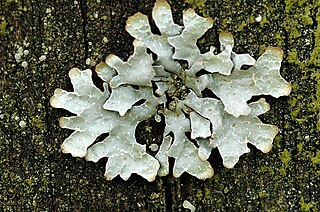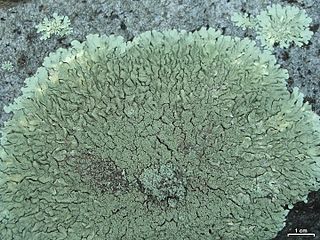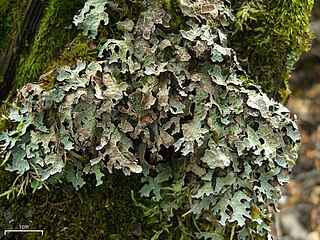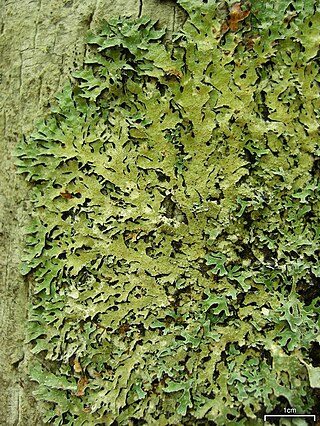
Parmelia is a genus of medium to large foliose (leafy) lichens. It has a global distribution, extending from the Arctic to the Antarctic continent but concentrated in temperate regions. There are about 40 species in Parmelia. In recent decades, the once large genus Parmelia has been divided into a number of smaller genera according to thallus morphology and phylogenetic relatedness.

Cetraria is a genus of fruticose lichens that associate with green algae as photobionts. Most species are found at high latitudes, occurring on sand or heath. Species have a characteristic "strap-like" form, with spiny lobe edges.

Parmelia sulcata, commonly known as the hammered shield lichen or cracked-shield lichen, is a foliose lichen in the family Parmeliaceae. First described by Thomas Taylor in 1836, it is one of the most prevalent lichen species globally, known for its resilience to pollution and cosmopolitan distribution across temperate and cold regions of both hemispheres. P. sulcata forms a circular thallus up to 10 cm (4 in) in diameter, with a glaucous white to grey upper surface and a black lower surface, featuring broadly lobed structures with both marginal and laminal soralia and a distinctive reticulate pattern of pseudocyphellae.

Melanohalea is a genus of foliose lichens in the family Parmeliaceae. It contains 30 mostly Northern Hemisphere species that grow on bark or on wood. The genus is characterised by the presence of pseudocyphellae, usually on warts or on the tips of isidia, a non-pored epicortex and a medulla containing depsidones or lacking secondary metabolites. Melanohalea was circumscribed in 2004 as a segregate of the morphologically similar genus Melanelia, which was created in 1978 for certain brown Parmelia species. The methods used to estimate the evolutionary history of Melanohalea suggest that its diversification primarily occurred during the Miocene and Pliocene epochs.

Melanelixia is a genus of foliose lichens in the family Parmeliaceae. It contains 15 Northern Hemisphere species that grow on bark or on wood. The genus is characterized by a pored or fenestrate epicortex, and the production of lecanoric acid as the primary chemical constituent of the medulla. Melanelixia was circumscribed in 2004 as a segregate of the related genus Melanelia.

Punctelia is a genus of foliose lichens belonging to the large family Parmeliaceae. The genus, which contains about 50 species, was segregated from genus Parmelia in 1982. Characteristics that define Punctelia include the presence of hook-like to thread-like conidia, simple rhizines, and point-like pseudocyphellae. It is this last feature that is alluded to in the vernacular names speckled shield lichens or speckleback lichens.

Xanthoparmelia is a genus of foliose lichens in the family Parmeliaceae. This genus of lichen is commonly found in the United States, South America, southern Africa, Europe, Australia, and New Zealand.
Parmelia asiatica is a species of corticolous (bark-dwelling) foliose lichen in the family Parmeliaceae. It was described as new to science in 2011 by lichenologists Ana Crespo and Pradeep Divakar, based on specimens from Yunnan, China. Since then, its known distribution has expanded to include various regions of Russia, parts of North America, and as of 2024, European Russia. The species is found in the forests of temperate and boreal climates, growing on the bark of various tree species. Parmelia asiatica is distinguished by its small thallus with narrow, more or less linear lobes, soralia that appear at the ends of the lobes, marginal linear pseudocyphellae, and a chemical composition that includes atranorin, salazinic acid, and consalazinic acid. While similar to other Parmelia species, it can be differentiated from them by its morphological and chemical characteristics.
Emodomelanelia is a lichen genus in the family Parmeliaceae. It is monotypic, containing the single foliose Himalayan species Emodomelanelia masonii.

Notoparmelia is a genus of foliose lichens in the family Parmeliaceae. It includes 18 species that grow on bark and rocks, and are mostly distributed in the Southern Hemisphere. The genus was created in 2014 as a segregate of Parmelia.
Parmelia mayi is a species of foliose lichen in the family Parmeliaceae. It is found in the northern Appalachian Mountains of eastern North America, where it grows on rocks and on the trunks of paper birch and balsam fir. Parmelia mayi is morphologically indistinguishable from Parmelia saxatilis, but is distinct in its distribution, chemistry, and genetics.

Parmelia barrenoae is a species of foliose lichen in the large family Parmeliaceae. It was formally described as a new species in 2005. Before this, it was lumped together as one of several lichens in the Parmelia sulcata group—a species complex of genetically distinct lookalikes. Parmelia barrenoae is widely distributed, occurring in Europe, western North America, Africa, and Asia.

Parmelia fraudans is a species of foliose lichen in the family Parmeliaceae. It is found in Europe and North America, where it grows on rocks.
Parmelia imbricaria is a species of foliose lichen in the family Parmeliaceae. Found in western Canada, it was formally described as a new species in 2017 by Trevor Goward, Pradeep Kumar Divakar, María del Carmen Molina, and Ana Crespo. The type specimen was collected by Goward near the Clearwater River drainage, where it was found at an elevation of 700 m (2,300 ft) growing on a basalt boulder. The specific epithet refers to the "imbricate" lobes of the thallus. The lichen occurs in western Canada, with a range including southern Yukon and extending south to southern inland British Columbia. The European Parmelia pinatifida is a closely related species.
Parmelia encryptata is a species of corticolous (bark-dwelling), foliose lichen in the family Parmeliaceae. Found in the Iberian Peninsula, it was formally described as a new species in 2011 by Ana Crespo, Pradeep Kumar Divakar, and Maria del Carmen Molina. It is cryptic species that is a member of the Parmelia sulcata species complex, and it is morphologically indistinguishable from that lichen. Molecular phylogenetic analysis, however, shows that it is a genetically unique species originating from a different lineage. Parmelia encryptata has been estimated to have diverged from the P. squarrosa complex about 5.4 million years ago.
Parmelia isidiiveteris is a fossilised species of foliose lichen in the family Parmeliaceae. It was found in Dominican amber and described as a new species in 2000. It was tentatively placed in the genus Parmelia although its true generic placement is difficult to determine with only a single specimen available for analysis.
Parmelia rojoi is a species of foliose (leafy), saxicolous (rock-dwelling) lichen in the large family Parmeliaceae. It is known to occur in a couple of humid forests in southern Spain. It is quite similar in appearance to the more widespread Parmelia saxatilis, but has a more fragile thallus and smaller isidia.

Parmelia squarrosa, commonly known as the bottlebrush shield lichen, is a species of foliose lichen in the family Parmeliaceae. It occurs in east Asia, Europe, and eastern North America, where it typically grows on tree bark, much less frequently on rocks, and rarely on moss. Because of its abundance, widespread distribution, and stable populations, it has been assessed as a species of least concern by the International Union for Conservation of Nature. Parmelia saxatilis is quite similar in appearance Parmelia squarrosa and the latter was quite often confused with the former, especially in herbarium collections. Molecular phylogenetic analysis proved the genetic distinctness between the two species, which are morphologically distinguished by difference in rhizine structure.

Parmelia pinnatifida is a species of foliose lichen in the family Parmeliaceae, first recognised as a distinct species in 1976. Originally classified as a variety of P. omphalodes in 1803, it is characterised by its small, circular body (thallus) with narrow, highly branched, overlapping lobes, and its grey to brown upper surface contrasting with a black underside. While its status as a separate species has been debated, modern genetic studies support this classification, though some uncertainty remains. The lichen typically grows on siliceous (silicon-rich) rocks, and occasionally on moss, plant debris, or tree bark, showing a preference for humid environments. It has been documented across Europe, North America, and Antarctica, with populations in mountainous regions, though its reported presence in the Southern Hemisphere requires further verification.

Parmelia submontana is a species of corticolous (bark-dwelling), foliose lichen in the family Parmeliaceae. First described in 1987, it is characterised by a loosely attached, greenish-grey thallus reaching diameters of 10–15 cm (4–6 in), with elongated linear lobes and distinctive powdery structures for reproduction. The species has a complex taxonomic history, having been independently discovered twice – first in Greece in 1832 and later in eastern Bohemia in 1951 – and was long confused with related species before being recognised as distinct. Distinctive characteristics of the lichen include its simple to forked rhizines, which differ from the squarrose rhizines found in closely related species, and its blistered rounded soralia that develop from pseudocyphellae.













